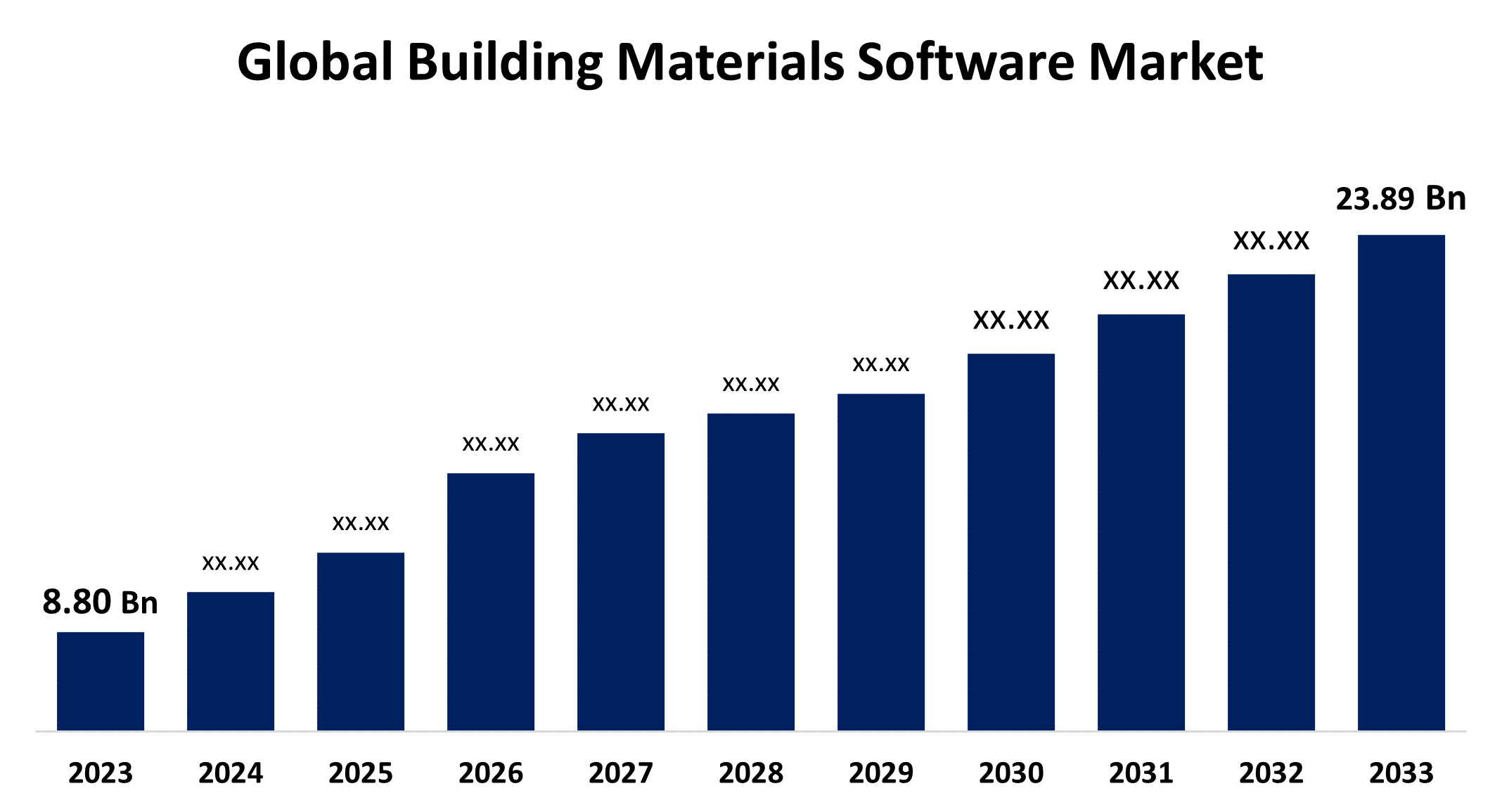Global Building Materials Software Market Size, Share, and COVID-19 Impact Analysis, By Product (Bitumen, Rubber, Metal, Polymer), By Type (On-Premises, Cloud-Based), By End-User (Residential, Commercial, Industrial), and By Region (North America, Europe, Asia-Pacific, Latin America, Middle East, and Africa), Analysis and Forecast 2023 - 2033
Industry: Advanced MaterialsGlobal Building Materials Software Market Insights Forecasts to 2033
- The Global Building Materials Software Market Size was Valued at USD 8.80 Billion in 2023
- The Market Size is Growing at a CAGR of 10.50% from 2023 to 2033
- The Worldwide Building Materials Software Market Size is Expected to Reach USD 23.89 Billion by 2033
- Asia Pacific is Expected to Grow the fastest during the forecast period.

Get more details on this report -
The Global Building Materials Software Market Size is Anticipated to Exceed USD 23.89 Billion by 2033, Growing at a CAGR of 10.50% from 2023 to 2033.
Market Overview
Building materials software is a specialized computer program designed to assist in the management, design, and analysis of building materials used in construction projects. Building materials software enhances efficiency and accuracy in construction and architecture by facilitating 3D design and simulations, aiding in project management tasks like scheduling and budgeting, and optimizing material selection. It manages supply chains, ensures regulatory compliance, supports stakeholder collaboration, oversees quality control, and promotes sustainability through environmental impact assessments and improved energy efficiency.
Building materials software is essential for enhancing efficiency, reducing costs, and fostering innovation in the industry. It streamlines operations through better data management, integrates with various systems for seamless workflows, and supports sustainability efforts by optimizing resource use and meeting green building standards. Additionally, it aids in regulatory compliance and improves customer experience by enabling tailored solutions and better communication.
Report Coverage
This research report categorizes the market for building materials software based on various segments and regions forecasts revenue growth and analyzes trends in each submarket. The report analyses the key growth drivers, opportunities, and challenges influencing the building materials software market. Recent market developments and competitive strategies such as expansion, product launch, development, partnership, merger, and acquisition have been included to draw the competitive landscape in the market. The report strategically identifies and profiles the key market players and analyses their core competencies in each sub-segment of the building materials software market.
Global Building Materials Software Market Report Coverage
| Report Coverage | Details |
|---|---|
| Base Year: | 2023 |
| Market Size in 2023 : | USD 8.80 Billion |
| Forecast Period: | 2023-2033 |
| Forecast Period CAGR 2023-2033 : | 10.50% |
| 2033 Value Projection: | USD 23.89 Billion |
| Historical Data for: | 2019-2022 |
| No. of Pages: | 216 |
| Tables, Charts & Figures: | 110 |
| Segments covered: | By Product, By Type, By Region, By End-User |
| Companies covered:: | ECi Spruce, NetSuite, Siemens AG, Ponderosa, Oneir, Pure Technology, Kerridge, Epicor, S2K, Agility, WoodPro InSight, MRPEasy, Honeywell International Inc., RealSTEEL, and Others Key Vendors. |
| Pitfalls & Challenges: | COVID-19 Empact, Challenges, Future, Growth, & Analysis |
Get more details on this report -
Driving Factors
The growth of the building materials software market is propelled by rapid technological advancements such as building information modeling (BIM) and artificial intelligence, which enhance efficiency and collaboration in construction projects. Increased demand for cost savings and operational efficiency, coupled with the focus on sustainability and green building practices, further fuels the market. The construction industry is growing, necessitating digital solutions for data analytics, customization, scalability, and stakeholder collaboration driving the growth of the building materials software market.
Restraining Factors
The building materials software market is hindered by several factors including high implementation costs and the complexity of training required for effective use. Integration with existing systems and concerns about data security and privacy can also deter adoption. Economic fluctuations and varying regulatory requirements further complicate the adoption of the building material software market.
Market Segmentation
The building materials software market share is classified into product, type, and end-user.
- The metal segment is estimated to hold the highest market revenue share through the projected period.
Based on the product, the building materials software market is classified into bitumen, rubber, metal, and polymer. Among these, the metal segment is estimated to hold the highest market revenue share through the projected period. The metal segment dominance is attributed to the widespread use of metal in construction for structural frameworks, roofing, and facades, which drives demand for advanced software solutions to manage complex design and engineering requirements. The segment's growth is further supported by ongoing innovations, stringent industry standards, and the high volume of large commercial and industrial projects utilizing metal.
- The cloud-based segment is anticipated to hold the largest market share through the forecast period.
Based on the type, the building materials software market is divided into on-premises and cloud-based. Among these, the cloud-based segment is anticipated to hold the largest market share through the forecast period. The dominance of the cloud-based segment is due to the benefits of cloud solutions, such as enhanced accessibility, cost-effectiveness through subscription models, and scalability to meet varying project demands. Cloud-based software also offers automatic updates and seamless integration with other tools, along with robust data security and backup features.
- The commercial segment dominates the market with the largest market share through the forecast period.
Based on the end-user, the building materials software market is categorized into residential, commercial, and industrial. Among these, the commercial segment dominates the market with the largest market share through the forecast period. The complexity and scale of commercial construction projects require advanced software for efficient design and management. High budgets and stringent regulatory compliance in commercial projects drive demand for the building software market. Furthermore, the integration of new technologies and materials in commercial construction further supports the segment's significant market share.
Regional Segment Analysis of the Building Materials Software Market
- North America (U.S., Canada, Mexico)
- Europe (Germany, France, U.K., Italy, Spain, Rest of Europe)
- Asia-Pacific (China, Japan, India, Rest of APAC)
- South America (Brazil and the Rest of South America)
- The Middle East and Africa (UAE, South Africa, Rest of MEA)
North America is anticipated to hold the largest share of the building materials software market over the predicted timeframe.

Get more details on this report -
North America is anticipated to hold the largest share of the building materials software market over the predicted timeframe. Advanced infrastructure, high technology adoption, and substantial construction activities across commercial, residential, and industrial sectors drive the growth of the North American region. The region’s strong investment capacity, focus on innovation, and research and development contribute significantly to the demand for building materials software.
Asia Pacific is expected to grow at the fastest CAGR growth of the building materials software market during the forecast period. The rapid growth is propelled by significant urbanization, robust economic expansion, and increased construction activities across the region. Countries like China and India are investing heavily in infrastructure and real estate, leading to higher demand for advanced software solutions. Furthermore, the region's focus on technological advancements, supportive government policies, and the emergence of developing markets contribute to the accelerated adoption of building materials software in the Asia Pacific region.
Competitive Analysis:
The report offers the appropriate analysis of the key organizations/companies involved within the building materials software market along with a comparative evaluation primarily based on their product offering, business overviews, geographic presence, enterprise strategies, segment market share, and SWOT analysis. The report also provides an elaborative analysis focusing on the current news and developments of the companies, which includes product development, innovations, joint ventures, partnerships, mergers & acquisitions, strategic alliances, and others. This allows for the evaluation of the overall competition within the market.
List of Key Companies
- ECi Spruce
- NetSuite
- Siemens AG
- Ponderosa
- Oneir
- Pure Technology
- Kerridge
- Epicor
- S2K
- Agility
- WoodPro InSight
- MRPEasy
- Honeywell International Inc.
- RealSTEEL
- Others
Key Target Audience
- Market Players
- Investors
- End-users
- Government Authorities
- Consulting And Research Firm
- Venture capitalists
- Value-Added Resellers (VARs)
Recent Developments
- In January 2024, Trunk Tools recently launched its second product, TrunkText. According to the company, the AI-based tool "reads" all documents and data linked with a project and uses the collected information to answer inquiries via a messaging app. It is intended to save contractors up to two hours each day.
- In September 2023, a leading global provider of construction management software, Procore Technologies, Inc. launched Procore Copilot, a new conversational and predictive experience powered by artificial intelligence that will enable users to automate labor-intensive, manual processes across the Procore platform.
Market Segment
This study forecasts revenue at global, regional, and country levels from 2023 to 2033. Spherical Insights has segmented the building materials software market based on the below-mentioned segments:
Global Building Materials Software Market, By Product
- Bitumen
- Rubber
- Metal
- Polymer
Global Building Materials Software Market, By Type
- On-Premises
- Cloud-Based
Global Building Materials Software Market, By End-User
- Residential
- Commercial
- Industrial
Global Building Materials Software Market, By Regional Analysis
- North America
- US
- Canada
- Mexico
- Europe
- Germany
- UK
- France
- Italy
- Spain
- Russia
- Rest of Europe
- Asia Pacific
- China
- Japan
- India
- South Korea
- Australia
- Rest of Asia Pacific
- South America
- Brazil
- Argentina
- Rest of South America
- Middle East & Africa
- UAE
- Saudi Arabia
- Qatar
- South Africa
- Rest of the Middle East & Africa
Frequently Asked Questions (FAQ)
-
1. What is the CAGR of the building materials software market over the forecast period?The building materials software market is projected to expand at a CAGR of 10.50% during the forecast period.
-
2. What is the market size of the building materials software market?The Global Building Materials Software Market Size is Expected to Grow from USD 8.80 Billion in 2023 to USD 23.89 Billion by 2033, at a CAGR of 10.50% during the forecast period 2023-2033.
-
3. Which region holds the largest share of the building materials software market?North America is anticipated to hold the largest share of the building materials software market over the predicted timeframe.
Need help to buy this report?